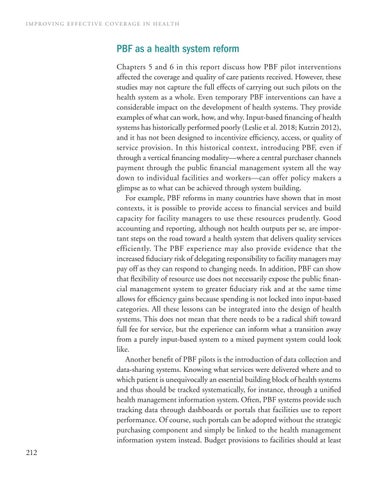IMPROVING EFFECTIVE COVERAGE IN HEALTH
PBF as a health system reform Chapters 5 and 6 in this report discuss how PBF pilot interventions affected the coverage and quality of care patients received. However, these studies may not capture the full effects of carrying out such pilots on the health system as a whole. Even temporary PBF interventions can have a considerable impact on the development of health systems. They provide examples of what can work, how, and why. Input-based financing of health systems has historically performed poorly (Leslie et al. 2018; Kutzin 2012), and it has not been designed to incentivize efficiency, access, or quality of service provision. In this historical context, introducing PBF, even if through a vertical financing modality—where a central purchaser channels payment through the public financial management system all the way down to individual facilities and workers—can offer policy makers a glimpse as to what can be achieved through system building. For example, PBF reforms in many countries have shown that in most contexts, it is possible to provide access to financial services and build capacity for facility managers to use these resources prudently. Good accounting and reporting, although not health outputs per se, are important steps on the road toward a health system that delivers quality services efficiently. The PBF experience may also provide evidence that the increased fiduciary risk of delegating responsibility to facility managers may pay off as they can respond to changing needs. In addition, PBF can show that flexibility of resource use does not necessarily expose the public financial management system to greater fiduciary risk and at the same time allows for efficiency gains because spending is not locked into input-based categories. All these lessons can be integrated into the design of health systems. This does not mean that there needs to be a radical shift toward full fee for service, but the experience can inform what a transition away from a purely input-based system to a mixed payment system could look like. Another benefit of PBF pilots is the introduction of data collection and data-sharing systems. Knowing what services were delivered where and to which patient is unequivocally an essential building block of health systems and thus should be tracked systematically, for instance, through a unified health management information system. Often, PBF systems provide such tracking data through dashboards or portals that facilities use to report performance. Of course, such portals can be adopted without the strategic purchasing component and simply be linked to the health management information system instead. Budget provisions to facilities should at least 212

